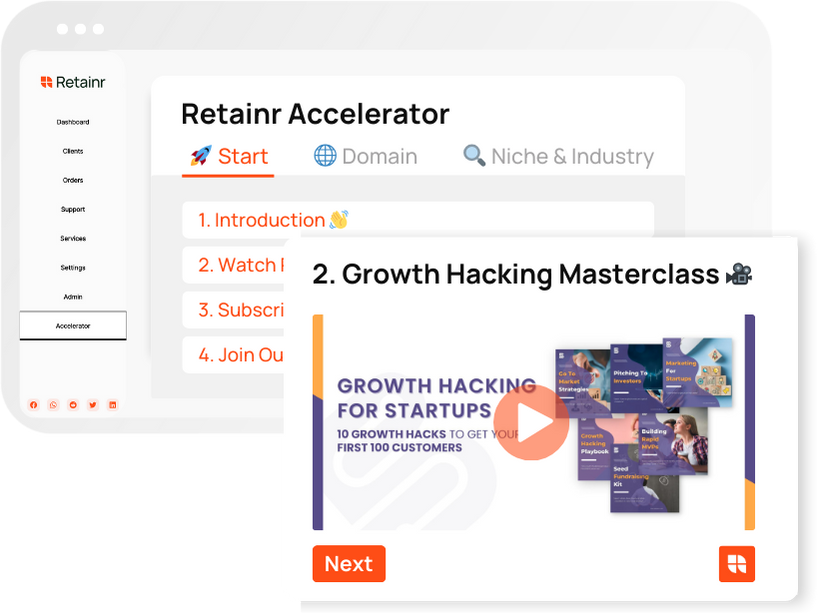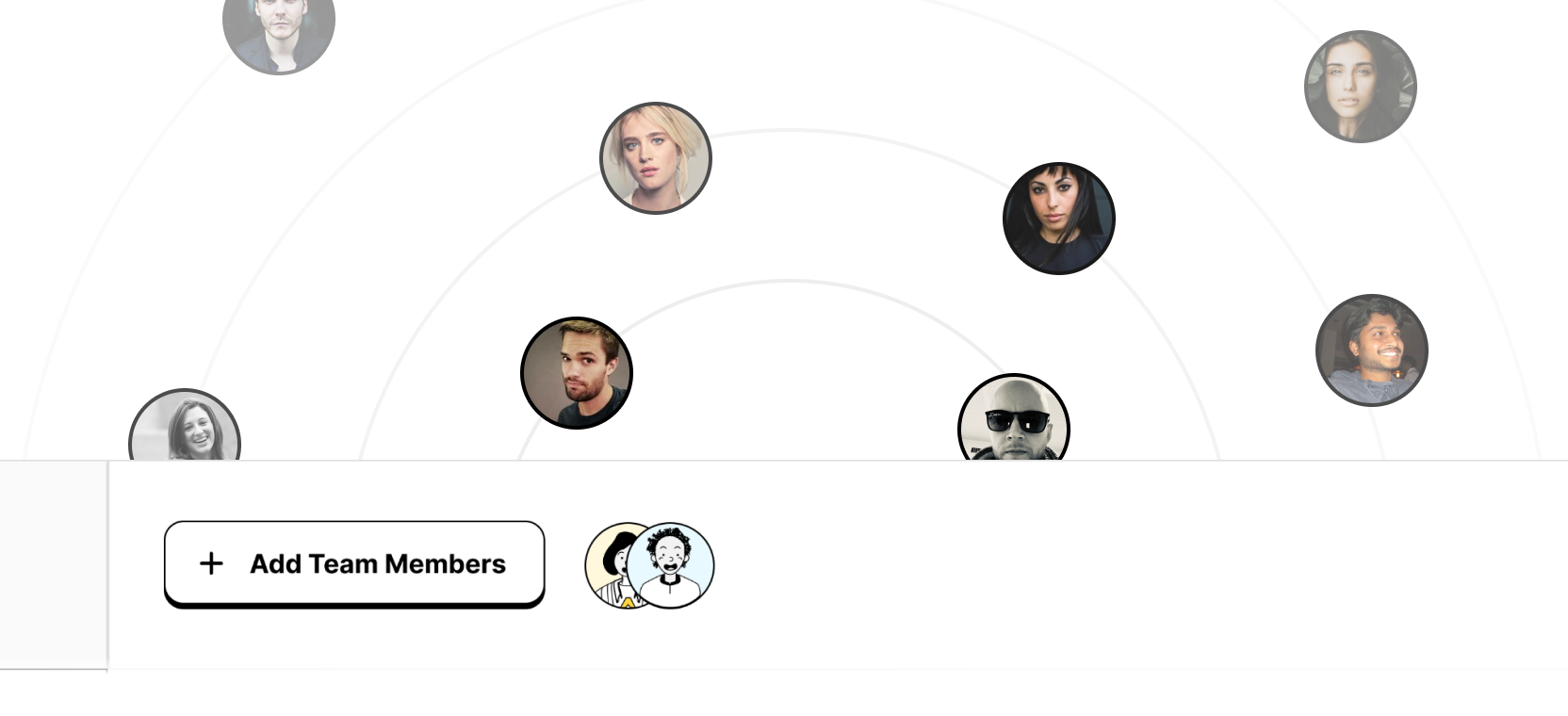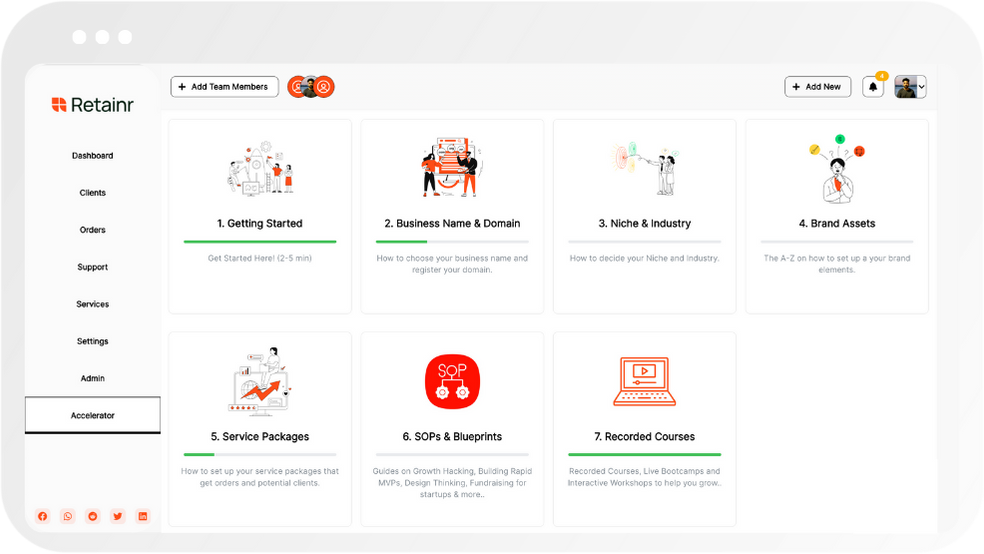
5 Tips for Building a Successful Email Marketing Campaign for Clients
Build with Retainr
Sell your products and services, manage clients, orders, payments, automate your client onboarding and management with your own branded web application.
Get Started1. What are the top five tips for building a successful email marketing campaign for clients?
Identifying Your Target Audience
Understanding your audience is the first key step to a successful email-marketing campaign. Knowing who they are, their interests and what triggers their engagement can massively boost your campaign's efficiency. Additionally, consider the following:
- Age
- Gender
- Location
- Purchasing habits
- Profession and income
Content Creation
Create content that resonates with your audience and aligns with your brand's unique voice. The content should add value to the reader and promote your brand or product effectively. Here, timing, visuals, and a compelling call-to-action are vital. Observe this table for clarity:
| Timing | Visuals | Call-to-Action |
|---|---|---|
| Send emails at optimal times when your audience is likely to be online. | Use eye-catching visuals related to your content and to your brand. | End your emails with a clear and compelling action for the reader to take. |
Testing and Analysis
Testing various elements of your email campaign before the official launch is essential. You can test subject lines, email formats, call-to-actions, and delivery times. Once the campaign is live, analyzing the campaign's success becomes crucial. Keep track of your:
- Open rates
- Click-through rates
- Conversions
This helps in understanding what works and what needs adjustments, paving your way towards a successful email marketing campaign.
2. How can a business personalize email marketing campaigns for its clients?
Understanding Client's Interest
The first approach towards a personalized email marketing campaign is by understanding the client's interest. This can be done through tracking the client's activity on your website or analyzing their previous purchases. Any data that provides insight into the client's preferences can be used to make the emails more relevant. For instance:
- Recommending products similar to their previous purchases
- Sending updates related to topics they showed an interest in
- Inviting them to events related to their interest
Personalized Communication
Technology advancement has made it possible to add a personal touch to bulk emails. There are email marketing software that allow for components of the email like the greeting or the body content to be personalized based on the data of each recipient. Here's how a business can personalize communication:
- Addressing the recipient by their name
- Sending the email from a personal account instead of a generic business account
- Using casual language if the data shows the recipient prefers it
Data segmentation
Data segmentation is another powerful way to personalize email marketing campaigns. This involves dividing your email list into different segments based on various criteria in order to send more targeted content. For instance:
| Segment | Example of Email Content |
|---|---|
| New clients | Welcome message and introduction to your business |
| Regular clients | Updates on new products or services, loyalty rewards |
| Clients who haven't purchased in a while | Special discounts or offers to re-engage them |
3. Why is segmentation important in building an email marketing campaign?
The Importance of Segmentation in Email Marketing Campaigns
One key aspect of building successful email marketing campaigns is through appropriate segmentation. Segmentation refers to the practice of dividing your email list into specific groups based on certain criteria. This can be something as simple as age or gender, or more targeted like purchasing behavior or geographical location. There are three main motivations behind the strategic implementation of segmentation tactics in email marketing campaigns.
Firstly, the primary reason is personalization. Providing content specifically tailored to the needs and interests of the individual recipient can significantly enhance user engagement. A study by Mailchimp showed segmented campaigns receive a 14.37% higher open rate than non-segmented campaigns. Secondly, segmentation can lead to a boost in revenue. Segmenting your email list can support the delivery of relevant promotions, increasing the likelihood of conversion. Lastly, segmentation can also help improve customer retention. By delivering valuable, personalized content, you give your recipients a reason to stay subscribed and engage with your emails.
| Priority | Benefit | Impact |
|---|---|---|
| Personalization | Enhanced user engagement | 14.37% higher open rate |
| Increased Revenue | Relevant promotions | Boost in Conversions |
| Customer Retention | Personalized, valuable content | Improved Subscriber Engagement |
4. How can one make sure their email content is effective and engaging for their clients?
Making Sure Your Email Content is Engaging and Effective
Email marketing is dependant on creating valuable content that urges action from recipients as well as fostering relationships. The main target always should be delivering engaging and effective content. Astounding content can boost customer interaction rates, fostering elevated traffic towards your website, creating leads and evolving prospective clients into loyal customers. Here are a few methodologies to ensure your email content is engaging and effective:
- Create Personalized Content: Emails that are personalized and tailored to match the desires of individual recipients are always more effective. You should make an effort to segment your audience using parameters like age, interests, location and purchase history. Tailored content results in more profound customer engagements that breed loyalty.
- Provide Valuable Content: A rule of thumb; always deliver content that provides some form of value to your customers. Educative, useful or entertaining content encourages better engagement. Understand your audience and what they find beneficial.
- Visuals and Interactive Components: Visual elements like infographics, photos, graphs, and videos can amplify information comprehension. Meanwhile, interactive components like clickable links and buttons stimulate engagement and direct traffic to your website.
- Offer Exclusive Deals: Incentives like exclusive deals and discounts for newsletter subscribers not only increases signups but also spurs recipient engagement.
- Make it Mobile-friendly: With the upswing of mobile device usage, ensure that your emails are optimized to look great on all devices and screen sizes.
The following table shows how effective the listed strategies are and how difficult it might be to implement them:
| Strategy | Ease of Implementation | Effectiveness |
|---|---|---|
| Create Personalized Content | Medium | High |
| Provide Valuable Content | Medium | High |
| Use Visuals and Interactive Components | Medium to High | High |
| Offer Exclusive Deals | Low | Very High |
| Make it Mobile-friendly | High | Very High |
5. What metrics or KPIs should be monitored when running an email marketing campaign?
Key Performance Indicators for Email Marketing Campaigns
Measuring the success of an email marketing campaign involves several key performance indicators (KPIs). Monitoring these metrics provides an understanding of how effective the campaign is, what's working, and what might need to be adjusted as the campaign progresses. Some key KPIs to monitor include:
- Open Rate - This is the percentage of recipients who open your email. A high open rate could indicate a successful subject line or sender name.
- Click-Through Rate (CTR) - This shows the percentage of people who clicked at least one link in the email. It tells you how many people were engaged enough to take the next step.
- Conversion Rate - This is the percentage of recipients who complete the desired action, such as making a purchase, signing up for a webinar, filling a form etc.
- Bounce Rate - Represents the percentage of total emails sent that could not be delivered to the recipient's inbox.
- Unsubscribe Rate - This shows how many recipients have opted to no longer receive your emails. Studies show that a good unsubscribe rate should be less than 0.5%.
Metrics Explained with an Example
For a clear understanding of how to use these metrics in email marketing, let's consider a campaign that sends 1,000 emails, has 200 opens, 30 clicks, and 3 conversions.
| Metric | Calculation | Value |
|---|---|---|
| Open Rate | (Number of opens / Number of emails sent) * 100 | 20% |
| Click Through Rate | (Number of clicks / Number of emails sent) * 100 | 3% |
| Conversion Rate | (Number of conversions / Number of emails sent) * 100 | 0.3% |
Keeping track of these metrics and analyzing them can enable you to make necessary tweaks for enhanced engagement, conversion, and ultimately, better results in your email marketing campaigns.
6. How can my business build a high converting email list for my marketing campaign?
Building a High Converting Email List
A high converting email list is a key aspect of a successful email marketing campaign. Even with the most enticing and persuasive marketing emails, your efforts will be for naught if they are not reaching the right target audience. The following five guides explain how your business can build a high converting email list.
- Offer Value: Your objective should be to persuade your audience that subscribing is worthwhile. Provide useful content, exclusive offers or professional insights, depending on your industry.
- User Experience: Make the subscription process as easy as possible. Placement of the sign-up button, the number of steps in the process, and even the colour choices can influence someone's decision to sign up.
- Promote Your Newsletter: Make use of all your marketing channels to promote your newsletter. Include a call to action in your social media posts and blog articles, inviting your followers to join your email list.
- Quality Over Quantity: Rather than trying to add as many email addresses to your list as possible, focus on those persons who exhibit genuine interest in your product or service.
- Consider Paid Advertising: While this may not be right for every business, using paid ads to promote your newsletter can help you attract more subscribers.
Measuring the Success of Your Email List
Your email list's success should be measured by more than just the number of subscribers. Other factors such as open rates, click-through rates, and conversion rates are essential indicators to monitor over time. Use the following table as a guide:
| Key Performance Indicator | What It Measures |
|---|---|
| Open Rate | The percentage of subscribers who open your email |
| Click Through Rate (CTR) | The percentage of subscribers who click on a link within your email |
| Conversion Rate | The percentage of subscribers who make a purchase, fill out a form, etc. after clicking on your email |
7. What role do CTAs (Call-to-Action) play in a successful email marketing campaign?
The Role of CTAs in Successful Email Marketing
The Call to Action (CTA) is a fundamental element of effective email marketing. Its role is to trigger a response or an action from the reader. It is the part of the email that instructs recipients about what they should do next.
- Email Engagement: A well-crafted CTA can significantly boost the engagement rate of your email campaign. It motivates your audience to interact with your emails, leading to higher click-through and conversion rates.
- Driving User Action: CTAs guide your recipients on what exactly to do, whether it’s to download a file, register for a webinar, buy a product, or simply get more information. This is key to achieving the goals of your email marketing campaign.
- Measuring Success: CTAs are not just for driving action, but also for measuring the effectiveness of your emails. By monitoring the CTA click-through rates, you can gain insights into your audience's behaviors and preferences, thus allowing you to continuously optimize your strategy.
Implementing Effective CTAs
Simply including a CTA in your email is not enough, its effectiveness greatly relies on its design, position, and message. Here are some tips to help improve your CTAs:
| Tips | Description |
|---|---|
| Clear and concise | Your CTA should communicate a clear, specific, and concise action. Avoid ambiguity and keep it simple yet compelling. |
| Visibility | Your CTA should be prominently placed and easily visible. It should stand out from the rest of the email content. |
| Relevance | Ensure that your CTA is relevant and aligns with the email theme and content. Irrelevant CTAs can lead to high bounce rates. |
| Persuasive Language | Use persuasive, action-oriented language to encourage the reader to take the desired action. |
| A/B Testing | Test your CTAs using A/B testing to find out what works best with your audience in terms of language, color, size, and placement. |
8. Which are the best practices to prevent my marketing emails from being marked as spam?
Follow the Guidelines for Opt-In/Opt-Off
Firstly, ensure that the recipient requested to receive your emails. This can be achieved by having a double opt-in process, where the user has to confirm their subscription through a link sent in a confirmation email. And, remember to include an easy way for the recipient to unsubscribe from your newsletter. If the user needs to send an email or fill out a form, they're more likely to mark your email as spam instead.
Quality Content and Clear Subject Lines
Next, concentrate on delivering quality content. The surest way to avoid the spam folder is to create content that people want to read. Write direct, unambiguous email subject lines to let the recipient know why you're emailing them. If your subject line suggests that the email contains one thing and the body says another, it may be marked as spam.
- Use a reputable email service provider
- Avoid using all caps and excessive exclamation marks in your subject line
- Personalize your emails
Stay Compliant to Regulations
Finally, get acquainted with and stay compliant to the CAN-SPAM Act. This law sets the rules for commercial email, gives recipients the right to stop the emails, and spells out penalties for violations.
| Regulation | Description |
|---|---|
| Don't use false or misleading header information | Your "From," "To," "Reply-To," and routing information must be accurate and identify the person or business who sent the email. |
| Don't use deceptive subject lines | The subject line must reflect the content of the email. |
| Identify the message as an ad | You must disclose clearly and conspicuously that your message is an advertisement. |
9. How frequently should a business send email newsletters or promotion emails to its clients?
Frequency of Sending Email Newsletters and Promotion Emails
Knowing exactly how often to send email newsletters or promotional emails to your clients is integral to the success of your email marketing campaign. The frequency with which you reach out to your clients can directly impact their engagement rates and ultimately your conversion rates. It is important to strike a balance between regular communication and spamming.
Recommended Email Frequency
Typically, businesses should aim to send email newsletters and promotional emails to their clients about once per week. This frequency provides enough touch points to keep your brand top of mind, but does not overwhelm your clients' inbox. Here is a table summarizing the average email frequency and its impact:
| Email Frequency | Pros | Cons |
|---|---|---|
| Daily | Ensures constant visibility. | Can lead to subscribers opting out due to overload. |
| Weekly | Keeps communication regular without overwhelming the recipient. | Some promotions or news might need to wait if they don’t fall into the sending schedule. |
| Monthly | Limits the chances for subscribers to opt out due to low frequency. | Lack of touchpoints can result in lower engagement. |
Factors Determining Email Frequency
- Customer Preferences: Remember that not all customers are the same. Some might appreciate daily updates, while others might prefer weekly or less often. It's a good idea to provide them options to choose their preferred frequency.
- Content Quality: It's better to send lesser but high-quality emails that provide value to your customers rather than frequent but poorly constructed emails.
- Type of Business: The nature of your business can determine the frequency; e-commerce sites might need to send emails more often than a software company.
10. Can you provide examples of successful email marketing campaigns and tips we could learn from them?
Examples of Successful Email Marketing Campaigns
There have been several successful email marketing campaigns in the past from which we can draw valuable lessons. For instance, Uber is known for its simple and clean email designs that directly communicate a clear call to action. Starbucks utilizes personalised offers in their campaigns to make customers feel special and valued. Lastly, the clothing brand ASOS, used an innovative strategy where they acknowledge shopping cart abandonment and offer customers a friendly reminder alongside relevant product recommendations.
Here is the comparison table of these campaigns:
| Brand | Campaign Strategy | Key Learning |
|---|---|---|
| Uber | Simple and clean email designs with direct CTA | Keep your message clear and straightforward. |
| Starbucks | Personalised offers | Personalisation helps in making customers feel special. |
| ASOS | Shopping cart abandonment | Addressing customer behaviours can lead to increased engagement. |
Tips Learned from Successful Email Marketing Campaigns
Based on these successful campaigns, here are five tips for building a successful email marketing campaign:
- Clarity is key: Your emails should communicate your message in the simplest and most clear way possible. Avoid any kind of jargon or complicated language.
- Personalise: Personalising your emails can greatly help in improving client engagement. This can range from addressing the client by their name to providing personalised offers and recommendations.
- Address client behaviours: Paying attention to and addressing how clients interact with your emails and website can lead to a higher engagement rate.
- Strategic use of CTAs: Your call-to-actions should be clearly visible and compelling enough to spur the client to take the desired action.
- Test and refine: Lastly, constantly testing different strategies and refining your approach based on the results is key to building a successful email marketing campaign.
Conclusion
Building a Successful Email Marketing Campaign
Creating a successful email marketing campaign involves meticulous planning, smart designing, interesting content, strategic scheduling, and effective analysing. Successful campaigns enhance your company's relationship with clients, encouraging loyalty and repeat business. Below are five tips for building a profitable campaign:
Plan Meticulously
This involves understanding the goals of the campaign, knowing your target audience, and categorizing your subscribers. It’s important to map out the strategy in advance. With Retainr.io, you can easily manage clients and orders.
Design Smartly
A campaign should reflect a professional image that resonates well with your audience. The use of visuals should be embraced but in a manner that does not overshadow the message. Retainr.io can help in ensuring consistency in your design.
Create Interesting Content
Engaging content is key in any campaign. The subject line, preheader text, and body content should captivate the audience. Retainr.io’s platform allows you to track how well your content resonates with your audience.
Schedule Strategically
Knowing the right time to send out your emails to achieve maximum read rates is crucial. Create a schedule based on when your recipients are most likely to read the email.
Analyse Effectively
Analyzing the results of your campaign can provide insights on what to improve in future. Retainr.io’s platform provides you with valuable analytics, making it easy to gauge the success of your campaigns.
Managing client relationships and monitoring your return on investment is made easier with Retainr.io. This white label software allows you to sell, manage clients, orders and payments with your own branded app. Make the smart move today and start managing your business processes easier.
Boost Your Agency Growth
with Retainr Accelerator
Uncover secrets, strategies, and exclusive blueprints to take your agency's growth to the next level — from marketing insights to effective presentations and leveraging technology.

SOPs, Cheatsheets & Blueprints
Leverage 50+ SOPs (valued over $10K) offering practical guides, scripts, tools, hacks, templates, and cheat sheets to fast-track your startup's growth.
Connect with fellow entrepreneurs, share experiences, and get expert insights within our exclusive Facebook community.
.jpg)

Join a thriving community of growth hackers. Network, collaborate, and learn from like-minded entrepreneurs on a lifelong journey to success.

Gain expertise with recorded Courses, Live Bootcamps and interactive Workshops on topics like growth hacking, copywriting, no-code funnel building, performance marketing and more, taught by seasoned coaches & industry experts.

.jpg)

.jpeg)


